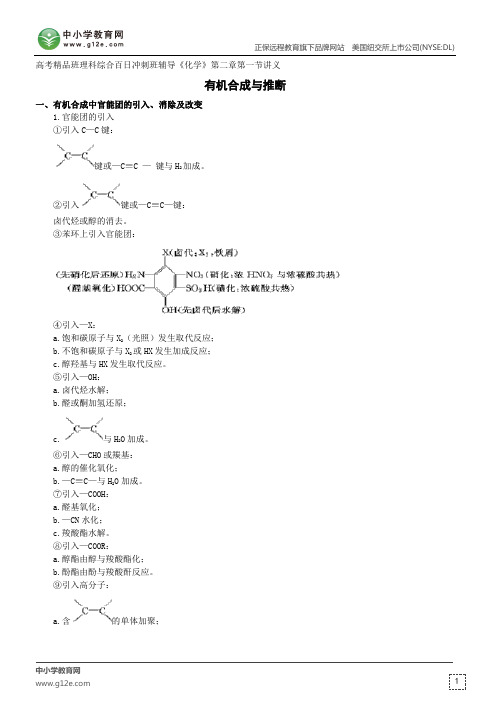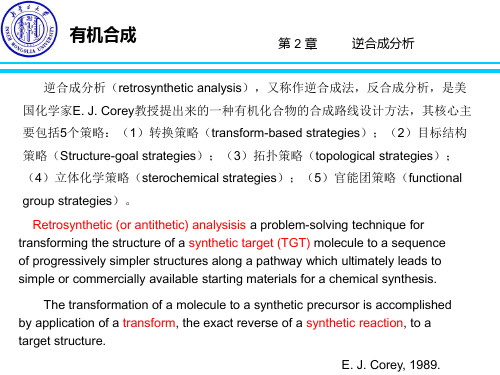有机合成化学第二章
现代有机合成化学第2章

A. β-酮酸酯:如β-丁酮酸乙酯,即乙酰乙酸乙酯
B. 丙二酸酯:如丙二酸二乙酯(C2H5OOCCH2COOC2H5)
C. β-二酮:即RCOCH2COR。
(1)β-酮酸酯的烃基化 通常都是在乙醇中用C2H5ONa或C2H5OK将它们转化成
A. 碱的影响
叔丁醇钾特别适用于酸性适中活泼亚甲基的烃基化。对于那些 酸性较弱的活性亚甲基化合物,则需用更强的碱,如氨基钠的液氨 溶液等作催化剂。
不对称的二酮在过量的碱存在下,可生成两种不同的
双负离子,当与烷基化试剂反应时,往往以一种烃基化产 物为主,即烃基首先进入取代基较少的α-碳。
B. 烃基化剂的影响
常见的能使α-氢活化的基团,其活化作用的大小顺序大致如下: -NO2>-COR>-SO2R>-COOR=CN>-SOR>-Ph
当一个碳上连有两个这样的基团时,这个碳上的氢就更加活泼, 也就表现出有更大的酸性。
由于活泼亚甲基化合物的酸性甚至比醇的酸性还强,因此它们 与醇钠的无水醇溶液作用即可形成一定浓度的烯醇负离子。
常用的烃化剂是卤代物。伯卤烷、仲卤烷、烯丙基卤、 苄卤等反应结果较好。叔卤烷则主要发生消除反应。
若采用非碱性的氟化硼或过氯酸银作催化剂,则叔卤代 烷亦可顺利进行烷基化反应。
选用伯卤烷为烃基化剂,可以得到较多的碳烃基化产物。
不同卤素的RX相比,反应活性如下:
RI>RBr>RCl
C.溶剂的影响
在非质子极性溶剂中,氧上烃基化比例增加; 在质子溶剂或非 极性溶剂中,碳上烃基化比例增加。
形成环状酮 (异常反应)
COOH COOH
有机合成路线-第二章.5

4、Diels-Alder反应具有高度的六体专一性,双烯物对亲双烯物进行 Diels-Alder反应具有高度的六体专一性, 反应具有高度的六体专一性 顺式加成,顺、反构型的亲双烯物在进行反应时,能保持其原有的基本 顺式加成, 反构型的亲双烯物在进行反应时, 构型,而且带有取代基的二烯物其加成反应也是按顺式进行的。 构型,而且带有取代基的二烯物其加成反应也是按顺式进行的。如:
OH
① O3 ② Me2S OHC
O
O
O
H , H2O
环状化合物无论其数量,还是其实际应用价值, 环状化合物无论其数量,还是其实际应用价值,都一直是合成 工作者们十分感兴趣的领域之一。目前成环方法主要有三类: 工作者们十分感兴趣的领域之一。目前成环方法主要有三类:第一 类成环反应是分子内形成的变型,在这一过程中,具有n个原子的 类成环反应是分子内形成的变型,在这一过程中,具有 个原子的 碳链环化成n元环;第二类反应是分子间的,涉及两个不同分子之 碳链环化成 元环;第二类反应是分子间的, 元环 间同时形成两个键,这种过程通常称为环加成反应,其中Diels间同时形成两个键,这种过程通常称为环加成反应,其中 Alder反应是一个典型的例子。第三类反应包含电环化反应,它是 反应是一个典型的例子。 反应是一个典型的例子 第三类反应包含电环化反应, 分子内反应而在机理方面与环加成有关。 分子内反应而在机理方面与环加成有关。
OMe O 1,6-Con FGI OMe
Me C H
⑵路线: 路线:
OMe Na,NH3(l) t-BaOH Me Me OMe ① O3 ②H2O/[Zn] O Me C H
Me
Me
O
Me NaBH4 O OM C OH
五、Diels-Alder反应在有机合成中应用 反应在有机合成中应用
高等有机合成化学 02.4 分子重排反应

M B B B A A A B M B M B (亲核重排) (亲电重排) (自由基重排)
A M A M A
M=迁移基团(migration group);Y=离去基团; A=重排始点;B=重排终点
2013-8-23 6
根据迁移基团的距离,重排还可分为1,2-、1,3-、 1,4-、 重排。 大多数反应属于分子内1,2-重排,即迁移基团经 “桥”离子迁移到相邻原子上。
2013-8-23
3
2.4 分子重排反应
有机化学的反应中,经常涉及反应过程中分子骨架 发生改变的问题。例如E1反应中双键的移位,傅克烷基化反应中直链烃基转变为支链烃基等。
+ CH3CH2CH2Cl AlCl3
CH CH 3 CH 3
+
CH 2CH 2CH 3
) 正丙苯(35~31% 异丙苯(65~69% )
2013-8-23
5.
贝耶尔-菲林格重排
另一种将酮转变为羧酸衍生物的方法是酮与过酸作用 成酯的反应。该反应称为贝耶尔-菲林格(BaeyerVilliger)重排。
OH R2CO OH R R O+ RCOOR R'CO3H O R2C O O CR'
2013-8-23
18
6. 杰米扬诺夫重排 脂肪族或脂环族伯胺经重氮化作用,脱氮形成碳正 离子所发生的重排称为Demjanov重排。脂环族伯 胺重排后经常发生环缩小或扩大的反应,可用来 合成三到六元环。反应机理与瓦-梅重排相似。
而分子内重排则与其它分子无关,迁移基团自始至
终没有脱离原来的分子,仅从分子的一部分迁移到 另一部分。
2013-8-23
5
根据迁移基团和迁移终点电荷的性质,重排还可分 为正离子重排、负离子重排和自由基重排等。 它们分别为迁移基团迁移到正离子、负离子和自由 基上的反应。
精细有机合成单元反应_02卤化反应

2.5 饱和烃的取代卤化
2.5.2 一氯甲烷的氯化制多氯甲烷
以石油化工的廉价甲醇为原料,先与盐酸反应生成一氯甲烷,再 将一氯甲烷氯化成多氯甲烷。除高温气相热氯化法外,也可用液 相引发氯化法。
2.5.3 氯化石蜡
是以C10~C30的正构烷烃为原料,经取代氯化制得的产物的总称。
每种产品都是混合物,其化学式和相对分子质量都是平均值,商
Cl
Br
Cl2 , 15 ℃ 1,2- 二 氯 乙 烷 溶 剂 四 氯 化
HO
CH3 C CH3
OH
• -X(-Cl)
亲核置换 -NH2,-OH,-F,-OR,-OAr
OH
Cl
δ+
OH
OCH 3
OCH3 NH3
NH 2
2.1 概 述
(1) 氯化剂
2.1.1 卤化剂
最常用的氯化剂是氯气,价格低廉,供应量大。 液态SO2Cl2,反应温和、加料方便、计量准确,但价格太贵 在水介质中进行时,可用盐酸加双氧水、次氯酸钠和氯酸钠 (2) 溴化剂 最常用的是分子态溴,特别用于制备含溴的阻燃剂。 (3) 碘化剂
催化剂是废铁屑、废铁管。
(2) 苯的二氯化制对二氯苯催化剂:苯的二氯化时,如果用FeCl3作催化剂, 对/邻二氯苯的比例仅1.49 ~ 1.55︰1;Sb2S3,对/邻之比为3.3 ~ 3.6︰1; Sb2S3-I2,对/邻之比为7.5︰1;经氯氧混合气处理过的硫化铁-硅铝胶,对/ 邻之比为8.0︰1;经二氯乙酸钠等羧酸盐处理过的沸石,对位收率可达 95.7%。 (3) 甲苯的氯化制对氯甲苯:Lewis酸催化剂,对位选择性只有24% ~ 37%;
H-X + FeCl3 H+ + FeCl4-
有机合成与推断--高考精品班理科综合百日冲刺班辅导《化学》第二章第一节讲义

正保远程教育旗下品牌网站 美国纽交所上市公司(NYSE:DL)
中小学教育网
高考精品班理科综合百日冲刺班辅导《化学》第二章第一节讲义
有机合成与推断
一、有机合成中官能团的引入、消除及改变
1.官能团的引入
①引入C —C 键:
键或—C≡C — 键与H 2加成。
②引入键或—C≡C—键:
卤代烃或醇的消去。
③苯环上引入官能团:
④引入—X :
a.饱和碳原子与X 2(光照)发生取代反应;
b.不饱和碳原子与X 2或HX 发生加成反应;
c.醇羟基与HX 发生取代反应。
⑤引入—OH :
a.卤代烃水解;
b.醛或酮加氢还原;
c.
与H 2O 加成。
⑥引入—CHO 或羰基:
a.醇的催化氧化;
b.—C≡C—与H 2O 加成。
⑦引入—COOH :
a.醛基氧化;
b.—CN 水化;
c.羧酸酯水解。
⑧引入—COOR :
a.醇酯由醇与羧酸酯化;
b.酚酯由酚与羧酸酐反应。
⑨引入高分子:
a.含的单体加聚;。
第二章 逆合成分析

应的卤代物与活泼金属发生卤素交换反应来制备。
常见的d1合成子等价物主要有CH3NO2、CH3SOCH3、CH3SO2CH3、HCN、 磷叶立德、硫叶立德和硫代缩醛等。
常见的d2合成子合成子等价物主要有RCH2CHO、RCH2COPh、RCH2CO2Et、
CH2(CO2Et)2、CH3COCH2CO2Et和CH2(CN)2等。 常见的d3合成子合成子等价物:
有机合成
第2章
逆合成分析
常见的a3合成子主要有β-羰基正离子,其合成等价体是α,β –不饱和羰基化合物、 α,β –不饱和羧基化合物和α,β –不饱和腈。烯丙基正离子和炔丙基正离子也可以视为a3-
合成子,等价体为3-卤代丙烯、3-卤代丙炔、2-烯丙醇的磺酸酯和2-炔丙醇的磺酸酯。
常见的d合成子 常见的d0合成子主要有烷基负离子、烯基负离子和芳基负离子,它们通常由相
分析
TM
O
O
O
O
+
O O O
+
CH3I
有机合成
第2章
逆合成分析
5、逆推到适当阶段再切断
有些分子不能直接切断,或切断后得到的合成子在正向合成时,无合适 方法将其连接起来。此时,应将TM逆推到某一替代的TM后再切断。
eg. 合成
CH3CH CH2CH2OH OH FGI;Dis
CH3CH OH
+
CH2CH2OH
C-杂键不如C-C键稳定,且在合成时也易形成,合成时,C-杂键放在最后 几步完成,较为有利。一方面避免C-杂键受到早期反应的干扰,另一方面也 可在较温和的条件下连接,避免在后期反应中破坏已引进的官能团。合成中
后期形成的键,在分析时应先切断。
有机合成
有机合成化学知到章节答案智慧树2023年山东理工大学
有机合成化学知到章节测试答案智慧树2023年最新山东理工大学第一章测试1.下列关于烯烃的说法正确的是()。
参考答案:经臭氧化-还原得到醛或酮2.下列关于芳烃的说法正确的是()。
参考答案:磺化反应是可逆反应3.下列关于卤代烷的说法正确的是()。
参考答案:可经氢化锂铝还原为烷烃4.醇与二氯亚砜的反应一般不发生重排。
()参考答案:对5.卤苯一般不容易水解,但当邻对位有强吸电子基取代时,可在较温和条件下水解()。
参考答案:对第二章测试1.下列关于傅克烷基化反应的说法正确的是()。
参考答案:容易得到重排产物;容易得到多取代产物成2.下列关于傅克酰基化反应的说法正确的是()。
参考答案:傅克酰基化反应是可逆反应3.在频哪醇重排反应中,基团迁移速度是烷基>芳基()。
参考答案:错4.联苯胺重排是分子间反应。
()参考答案:错5.在强酸条件下,醛酮均可以发生施密特重排反应,但羧酸不可以()。
参考答案:错1.下列关于羟醛缩合反应的说法正确的是()。
参考答案:苯甲醛不能发生自身羟醛缩合反应2.下列关于碱催化缩合反应的说法正确的是()。
参考答案:酯在碱性条件下自身缩合得到1,3-酮酯的盐3.下列关于碱催化缩合反应的说法错误的是()。
参考答案:苯甲醛与乙酸酐反应制肉桂酸时,可用浓强碱促进反应4.下列反应体系可用于制备肉桂酸的是()。
参考答案:苯甲醛与乙酸酐在乙酸钠作用下;苯甲醛与丙二酸在哌啶作用下5.下列关于碱催化的烃基化反应的说法正确的是()。
参考答案:卤苯活性差,不易与丙二酸酯反应1.下列关于格氏试剂的说法正确的是()。
参考答案:烯丙基格氏试剂的制备一般在无水乙醚中顺利完成2.下列关于有机铜锂试剂的说法正确的是()。
参考答案:与α,β-不饱和酮的反应中,R2CuLi的R基团的构型不发生改变3.下列关于有机磷试剂的说法正确的是()。
参考答案:与羰基化合物的反应具有高度的位置专一性4.有机铜锂试剂与α,β-不饱和酮主要发生1,2-加成。
有机化学综合练习五(有机合成)
第二章 烷烃1. 化合物A (C 6H 12),在室温下不能使高锰酸钾水溶液裉色,与氢碘酸反应得B (C 6H 13I )。
A 氢化后得3-甲基戊烷,推测A 和B 的结构。
答案:第三章 立体化学20. 有一旋光化合物A (C 6H 10)能和Ag(NH 3)2NO 3作用生成白色沉淀B (C 6H 9Ag),将A 经过催化加氢,生成C (C 6H 14),C 没有旋光性,试写出A 的Fischer 投影式,B 和C 的构造式 答案:CCH 2CH 3CH 3HCH CCH 2CH 3H H 3CCH A:B:CH 3CH 2CH(CH 3)CCAgCH 3CH 2CH(CH 3)CH 2CH 3C:第四章 卤代烷2:化合物分子为C 8H 17Br ,用EtONa/EtOH 处理生成稀烃B ,分子式C 8H 16,B 经过臭氧化、锌/水处理生成C ,催化氢化时吸收1mol H 2生成醇D ,分子式C 4H 10O ,用浓硫酸处理D 主要生成两种稀烃的异构体E 和F ,分子式为C 4H 8,试推测A 到F 的结构。
答案:A: B:C: D:E+F: +第五章 醇和醚3. 化合物A (C 5H 12O )在酸催化下易失水成B ,B 用冷、稀KMnO 4处理得C (C 5H 12O 2)。
C 与高碘酸作用得CH 3CHO 和CH 3COCH 3,试推测出A 、B 、C 的结构。
答案:A:CH 3CCH 3CH 2CH 3CH 3CCH 3CHCH 3CH 3CCH 3CHCH 3B:C:4. 化合物,分子式为C 8H 18O ,常温下不与金属钠作用,和过量的浓氢碘酸共热时,只生成一种碘代烷,此碘代烷与湿的氢氧化银作用生成异丁醇,试写出该化合物的结构式。
答案:CH 32OCH 23CH 3CH 3第六章 稀烃5. 有两种分子式为C 6H 12的烯烃(A )和(B ),用酸性高锰酸钾氧化后,(A )只生成酮,(B )的产物中一个是羧酸,另一个是酮,试写出(A )和B )的结构式。
精细有机合成化学复习重点
第1章绪论1.1精细化学品的释义关于精细化学品的释义,国际上有三种说法:传统释义:产量小、纯度高的化工产品。
日本的释义:具有高附加值、技术密集型、设备投资少、多品种、小批量生产的化学品。
我国原则上采用日本对精细化学品的释义。
1.5 精细有机合成的原料资源精细有机合成的原料资源是煤、石油、天然气和动植物。
第2章精细有机合成基础2.1.2. 环上已有取代基的定位规律两类定位基:邻、对位定位基(第一类定位基):-O-, -N(CH3)2, - NH2, -OH, -OCH3, -NHCOCH3, -OCOCH3,-F, -Cl, -Br, -I, -CH3, -CH2Cl, -CH2COOH, -CH2F等。
间位定位基(第二类定位基):-N+(CH3)3, -CF3, -NO2, -CN, -SO3H, -COOH, -CHO,-COOCH3, -COCH3, -CONH2, -N+H3, -CCl3等。
2.1.3 苯环上取代定位规律2.1.3.1 已有取代基的电子效应诱导效应(I):由电负性大小决定。
共轭效应(T):包括π-π共轭和p-π共轭。
有+I,无T:2.1.4 苯环上已有两个取代基时的定位规律2.1.4.1 两个已有取代基的定位作用一致两个已有取代基为同一类型定位基,且处于间位。
两个已有取代基为不同类型定位基,且处于邻、对位。
2.1.4.2 两个已有取代基的定位作用不一致两个已有取代基为不同类型定位基,且处于间位。
——取决于第一类定位基两个已有取代基为同一类型定位基,且处于邻、对位。
——取决于定位能力的强弱2.4 精细有机合成中的溶剂效应(3)溶剂极性的本质——溶剂化作用每一个被溶解的分子或离子被一层或几层溶剂分子或松或紧地包围的现象,叫做溶剂化作用,它包括溶剂与溶质之间所有专一性和非专一性相互作用的总和。
按Lewis酸碱理论分类按起氢键给体的作用分类按专一性溶质、溶剂相互作用分类无机溶剂与有机溶剂;极性溶剂(电子对受体(EPA)溶剂与电子对给体(EPD)溶剂)与非极性溶剂。
有机合成化学2-官能团的引入与转化
benzene
+
O
O
O
O
(1) 共轭二烯烃是以顺式构象参与反应。被固定为反式的二烯体不 能发生此反应,如
而被固定的顺式反应速率大大加快,如
(2) 亲双烯体上有吸电子取代基,有利于反应。 (3) 此反应属协同反应,没有中间体,一步完成。
(4) 顺式加成,保持了二烯体、 亲二烯体的原有构型。
3. 还原反应
RCH CHCH2OH
Br2
RCH CHCH2OH Br Br
RCH CHCOOH
Zn
HNO3 RCHBrCHBrCOOH
3)醇脱水
RCH2CHR' OH
RCH CHR' + H2O
常用的酸性脱水剂有硫酸;磷酸;草酸;五氧化二磷等
CH3 H3C C CH
H3C OH
CH3
85% H3PO4
CH3
H3C C CH CH2
81%
19%
区域选择性——查依采夫(Saytzeff)规则
CH3 CH2CHCHCH3 KOH
Br
ห้องสมุดไป่ตู้
X CH3
CH2CH=C CH3
CH3 CH=CH CH
CH3
当消除能够得到共轭烯烃时,优先得到共轭烯烃。
2) 二卤代物脱卤
RCHCHR' XX
RCH CHR' + X2
常用的脱卤试剂有锌粉(或镍)的乙醇或乙酸溶液;钠的液氨溶液 等
CH3
CH3 + H3C C C CH3
CH3
醇脱水反应特点: ① 脱水速度—— 叔醇 > 仲醇 > 伯醇 ② 酸催化碳正离子中间体—— 易重排 ③ 区域选择性—— Saytzeff规则——形成多取代的烯烃 ④ 立体选择性—— 反式产物为主
- 1、下载文档前请自行甄别文档内容的完整性,平台不提供额外的编辑、内容补充、找答案等附加服务。
- 2、"仅部分预览"的文档,不可在线预览部分如存在完整性等问题,可反馈申请退款(可完整预览的文档不适用该条件!)。
- 3、如文档侵犯您的权益,请联系客服反馈,我们会尽快为您处理(人工客服工作时间:9:00-18:30)。
16
Formation of Enolates
17
Formation of Enolates
18
Formation of Enolates
pKa for active methylene compounds
19
Formation of Enolates
20
Popular Strong Bases
25
Explanation of Diastereoselectivity
Configuration of enolate controls the diastereoselectivity : Z-enolate leads to syn-aldol adduct.
Zimmerman–Traxler transition state models
Synthetic Organic Chemistry
合成化学
Lecture 02 Enolate Chemistry: Aldol and Related Reactions Dr. Shouyun Yu 俞寿云 副教授
1
Reading Assignment
Trost, B. M.; Brindle, C. S. Chem. Soc. Rev. 2010, 39, 1600. Geary, L. M.; Hultin, P. G. Tetrahedron Asymm. 2009, 20, 131. Guillena, G.; Najera, C.; Ramon, D. J. Tetrahedron Asymm. 2007, 18, 2249. Schetter, B.; Mahrwald, R. Angew. Chem. Int. Ed. 2006, 45, 7506. Cordova, A et al, Chem. Eur. J. 2006, 12, 5383. Palomo, C.; Oiarbide, M.; Garcia, J. M. Chem. Soc. Rev. 2004, 33, 65. Notz, W.; Tanaka, F.; Barbas, C. F. Acc. Chem. Res. 2004, 37, 580. Mahrwald, R. Curr. Org. Chem. 2003, 7, 1713. Alcaide, B.; Almendros, P. Eur. J. Org. Chem. 2002, 1595. Machajewski, T. D.; Wong, C. H. Angew. Chem. Int. Ed. 2000, 39, 1352. Johnson, J. S.; Evans, D. A. Acc. Chem. Res. 2000, 33, 325. Denmark, S. E.; Stavenger, R. A. Acc. Chem. Res. 2000, 33, 432.
2
Classification of Organic Reactions
■ Ionic
Ions or electrons moving in pairs
■ Pericyclic
Cyclic transition structures Concerted bond forming/breaking (not always synchronous) Single step with no intermediate
26
Explanation of Diastereoselectivity
Configuration of enolate controls the diastereoselectivity: E-enolate leads to anti-aldol adduct.
Zimmerman–Traxler transition state models
Although the Aldol reaction that Wurtz discovered in 1872 has C. A. Wurtz become a staple in organic synthesis. Alexander P. Borodin is (1817−1884) also credited with the discovery of the Aldol reaction together with Wurtz. In 1872 he announced to the Russian Chemical Society the discovery of a new byproduct in aldehyde reactions with properties like that of an alcohol, and he noted similarities with compounds already discussed in publications by Wurtz from the same year.
A solution to polyketides —— Aldol Condensation
6
Aldol Condensation
The Aldol condensation is the coupling of an enolate ion with a carbonyl compound to form a -hydroxycarbonyl, and sometimes, followed by dehydration to give a conjugated enone. A simple case is addition of an enolate to an aldehyde to afford an alcohol, thus the name aldol.
21
Why Hindered Base
22
Regioselectivity
23
E- or Z- Lithium Enolates
Z-enolate: Bulky substrate and base, chelating additive (HMPA) E-enolate: Less hindered substate and base, polar R’
5
Structurally Diverse Polyketides
Erythromycin, with all our advantages, looks at present hopelessly complex, particularly in view of its plethora of asymmetric centers. by R B Woodward (1954)
■ Radical
Correlated movement of single electrons
3
Ionic Organic Reactions
4
Reaction with Carbonyl Group
Nucleophilic addition of aldehydes or ketones
28
Explanation of Diastereoselectivity
Z-boron enolate leads to syn-aldol adduct
29
Explanation of Diastereoselectivity
E-boron enolate leads to anti-aldol adduct
the Chemists’ Solutions
15
ห้องสมุดไป่ตู้
Selectivity of Aldol
D. Seebach
@ ETH
T. Mukaiyama 向山 光昭
D. A. Evans
@ Harvard
G. Stork
@ Columbia
Preformed enolates: a solution to chemo- and regioselectivity
Nucleophiles Hydride Organometallic species Enolates Electron-deficient alkenes Nitro alkane Allyl silane
Reactions Reduction 1,2-addition Aldol Baylis-Hillman Henry Sakurai
Wurts Coupling
8
Enols and Enolates
9
General Mechanism
The enol pathway
The enolate pathway
10
Classic Examples
11
Modern Examples
12
Selectivity of Aldol: the Challenge
♣ The use of dialkyl boron chloride reactants with large ligands (such as a cyclohexyl ring) in combination with small bases (such as Et3N) affords E-enolates
Wurtz, C. A. Bull. Soc. Chim. Fr. 1872, 17, 436−442.
7
About Wurts
Charles Adolphe Wurtz (1817−1884) was born in Strasbourg, France. After his doctoral training, he spent a year under Liebig in 1843. In 1874, Wurtz became the Chair of Organic Chemistry at the Sorbonne, where he educated many illustrious chemists such as Crafts, Fittig, Friedel, and van’t Hoff.
